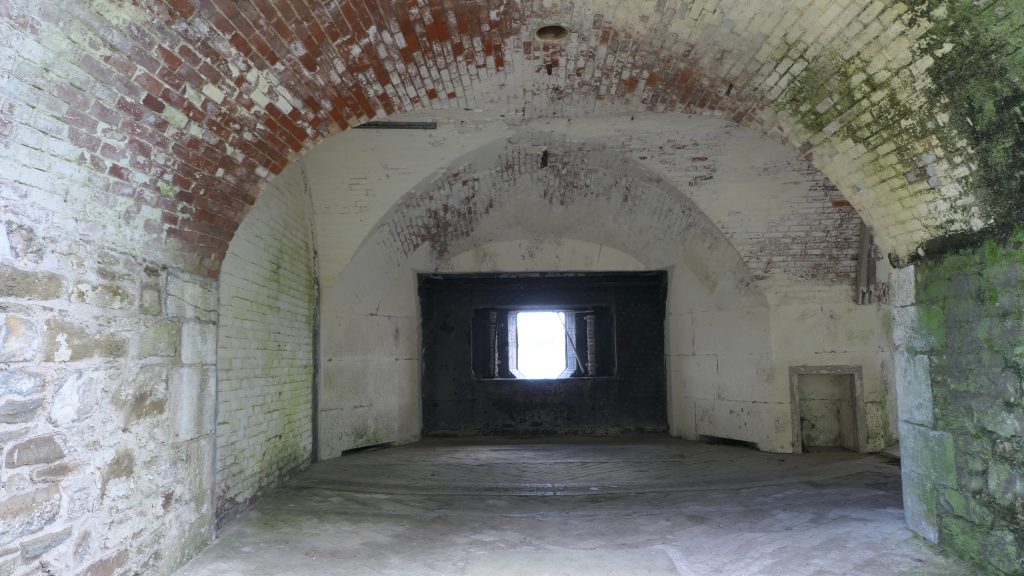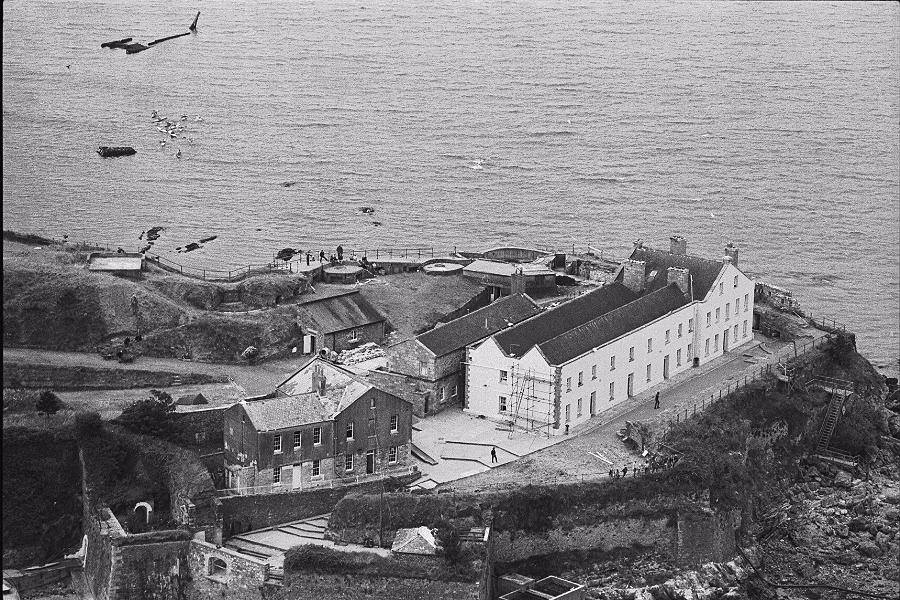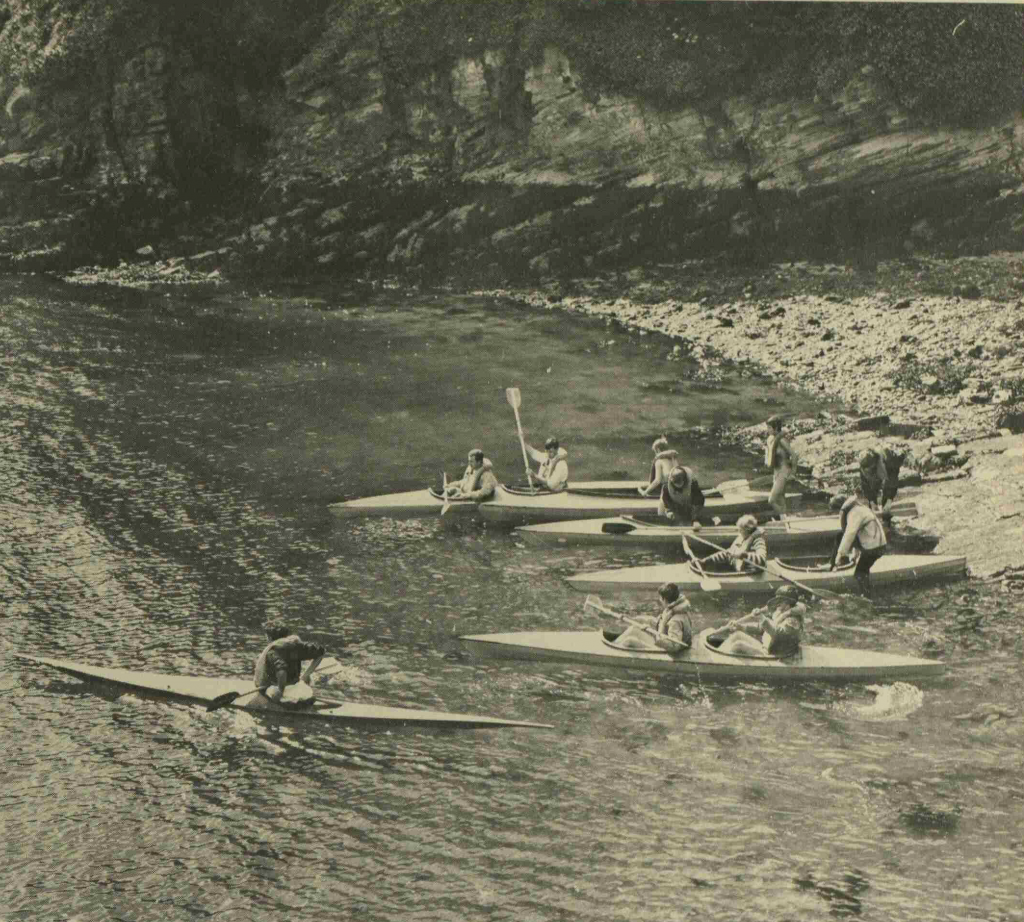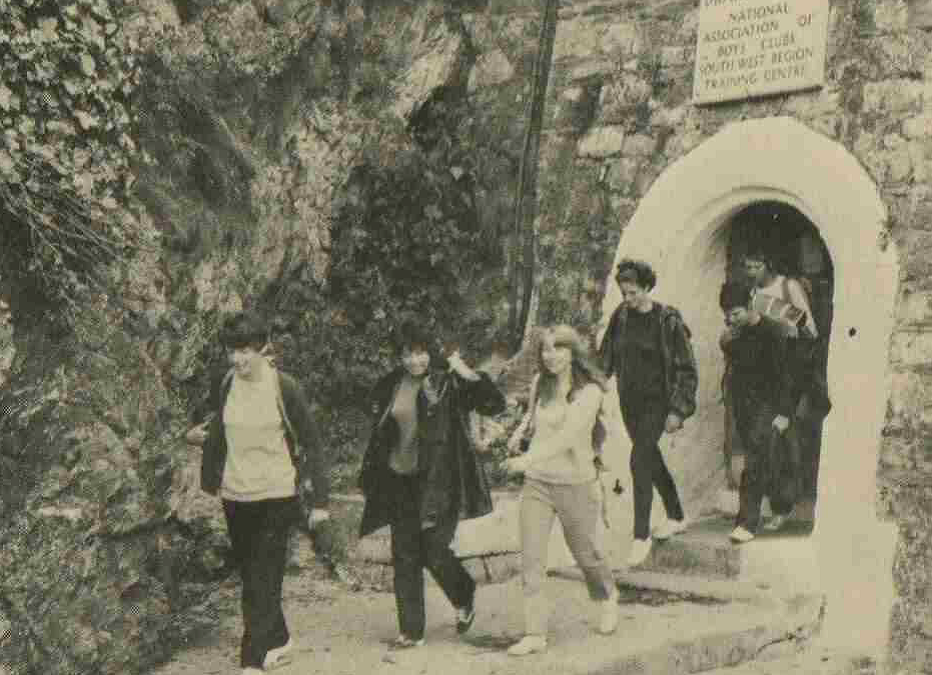The first activity of note on the Island was in 1961 when a group of 120 Plymouth Baptists made a pilgrimage to the Island and held a service in the memory of Abraham Cheare, a local Baptist Minister who was imprisoned on the Island in 1665 for his beliefs and died there in 1668. However looking to the future the National Trust leased the Island from the Crown in the same year. It seems it was to prevent ownership passing to private hands and it’s not clear if it was predetermined that it should be run as a Youth Training Base. However Stan Goodman, heading up the Drake’s Island Committee seems to have got involved at some point and the Committee appears to have been appointed to oversee the opening of the base. To help clean the site 9 (Parachute) Squadron Royal Engineers spent 10 days on the Island moving 1200 tons of rubble that the Engineers had created using high explosives a few years earlier. Heavy Plant, including a bulldozer were broken down and lifted in by Helicopter to help. The Engineers didn’t remove the rubble but shifted it out of the way so key areas, especially the Casemates could be opened.

The following year in 1962 the Committee launched a public fund raising appeal and also applied to the Council for grants. Things moved fairly quickly along and in 1963 the Ministry of Education and Council had agreed to grant £11,000 per year for 3 years to open the Centre. A warden was appointed at over £5,000 pa (the average salary was around £1,600). It was estimated that to connect the water and power would cost around £5,000. The committee also stated the Centre would be self-sufficient financially within 3 years, by 1967. It should be remembered that back in the day there were no detailed business plans or long term strategies and approval for the concept of the Centre and the funding was on the basis that those involved were good chaps – unfortunately women didn’t really feature back then.

However once the Engineers had cleared the way 16 of the 21 Casemates were leased out to various groups. The Sea Scouts, local schools, Cadet forces were amongst those who took advantage of the opportunity to have a base for sailing, kayaking and other outdoor pursuits. They were responsible for cleaning out their casemate and could adapt it how they wanted. Some used it as a store for holding equipment others installed camp beds or bunk beds with gas stoves and stayed over weekends and the school holidays. Power was supplied by a generator. The Casemateers as they became known were essentially to be separate to any courses that would be run on the Island. They would have use their own equipment for their activities and supply their own instructors if they wanted to run courses.

The following year in 1964 a small mains water pipe was installed by laying a pipe from the mainland near Artillery Tower at Devils Point. As was usual in those days the military and local public and private industry was called into help and did so for free. The Water Board assisted, the Harbour Master closed the sea lane, and local businesses also chipped in and a 6 man team of divers from the Royal Naval Engineering College attached the pipe to sea bed. Sewage disposal was by microbes in tanks that were cleaned out when necessary and grey water was pumped directly into Sound. The initial concept was for students to travel to the Island daily for courses and to develop residential accommodation as soon as possible. To that end roof repairs using 9000 slates were done to the main buildings which would house residential places. Other perhaps unrealistic plans were put forward for an underground Gym and Cinema in the magazine complex behind the Casemates. Although the Committee said the appeal for funds was off to a good start there were already rumblings about the amount of money being spent on the Island. The Warden had to explain through media interviews that 25% of the money was raised by appeal and with an expected 6-7000 students expected each year that the Centre would be self-sufficient within the 3 years agreed.

By the end of 1964 the Casemates were available for rent and some had been leased. Although rubble remained on the Island most had been moved so all areas were accessible and the Casemateers and course personnel had begun to break it up. The Island was to be opened in the summer for courses with the Warden and instructors staying on the Island – the Warden was the only full time employee, the instructors were all on summer contracts. Sailing and Canoeing were done around the Sound although it later developed into overnight stays away from the Island. There was bathing between Drake’s Island and Little Drakes Island with rock climbing and abseiling training on the inside of the Island and more advanced training done on the Rock Face on the South of the Island facing the Cornish Coast. It appears the Island was open from the start of May until around the end of September so about 5 months of the year.

Now the Committee had achieved its first target, to get the Centre open, it faced the challenge of making it financially self-sufficient. The first residential courses began in 1966 with spaces for 25 boys. To achieve their own target of 6,000 youths per annum this would mean at least 300 students going through per week although not all would have to be residential. The Committee realised that they would need to start looking at fund raising, grants and other sources of revenue as the student numbers and course revenue on their own would not be enough and especially as the initial grants from the Government and Council were only for the first three years. The Island was opened for a week in the summer to the general public to help raise funds and the committee was involved with year round fund raising efforts. On top of the realisation that funding may be an ongoing problem the water pipe broke for the first time in 1966 adding to the financial problems. The Island could still call on the goodwill of local firms and the military to help them out but it was not open ended. Naval recruits at the Raleigh Naval base who were sent to the Island to do useful work directed by the committee complained that the work they were being made to do was unnecessary. The Centre also opened at a time of considerable social change, people had more disposable income and family package holidays became more popular with foreign travel starting to become more popular all of which competed with the Island for people’s leisure time. Even the local schools who had subsidised places would start to look abroad for their school trips.
However on the surface all seemed well and the Island was visited by Prince Phillip in July 1967, the newspaper reported it as follows “DRAKE’S ISLAND GETS GOING AGAIN” “The Duke of Edinburgh said that he was very impressed with what he saw when he visited Drake’s Island adventure centre in Plymouth Sound in July. This six-acre island, which had been a fortress for four centuries until the army left it a few years ago, has taken on a new lease of life. In 1962 a committee of representatives of the National Association of Boys’ Clubs, the Department of Education and Science, and the National Trust was set up to plan its future. A number of local youth clubs took an immediate interest and initiative in converting parts of the old fortifications into living quarters, and centres for building canoes. Canoeing is only one of the activities for which this island is ideally suited. Others are rock-climbing, boating, swimming, skin-diving, and camping. Two years ago, full-time instructors were employed at the island, and courses were organised for boys and girls from 12 up. An old barrack block was refitted to provide dormitories, dining rooms, and kitchens. So far, £35,000 has been spent on the centre, but lack of funds makes progress slow at present. Parties who might wish to organise their own independent courses are also welcome at Drake’s Island, and even in the summer there seems to be plenty of room for everyone.” The report does mention full time instructors but this was just full time when the centre was open not year round employment. The report also notes the lack of funds and that there was plenty of spaces on the courses.

1968 was supposed to be the year by which the Island would become financially self-sufficient, however the Local Education Authority was spending more on Drake’s Island, partially subsidising the course cost for local school children, than they were on all other youth work in Plymouth. Up until 1969 power had been supplied using generators but that year a power cable was laid from the mainland to the Island. It’s not clear how it was funded although it seems likely that the local electricity board did it for free, the cable is still the property of Western Power. 1969 also saw one of the first efforts anywhere in the country to give disabled children and youths the chance to take part in adventure training. The next blog will cover the 1970’s as the centre constantly battles to stay open.


My dad was an instructor on the Island for a short while. He was serving in the RAF at the time, and got dispensation to work as an instructor. I remember spending at least one summer there
He has an interesting tale to tell, concerning a visit by one of the Kennedy children, if you would like to hear from him?
Hi Stephen
Thanks for getting in touch, JFK Jr was on the Island in the 1970’s with his cousin Antony Ridizwilli. One of our Rangers was his sailing instructor and there is a bit about his visit in one of the other blogs but I’d always like to learn more so if your Dad has any memories about JFK Jr or any other tales from his time as an instructor I’d love to hear from him. I’ll PM you my email address as the best way to get in touch. Thanks again, Bob